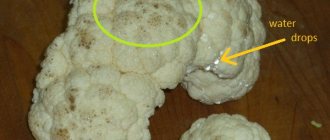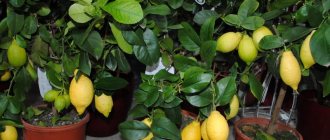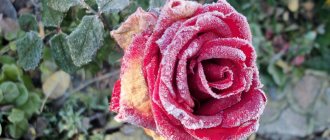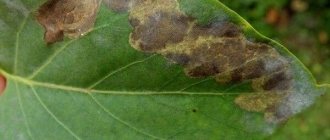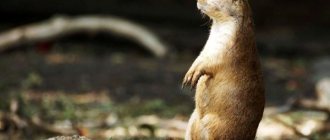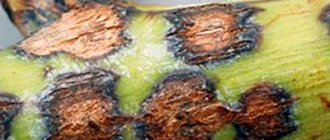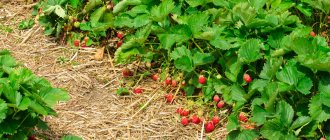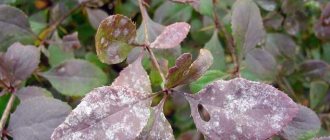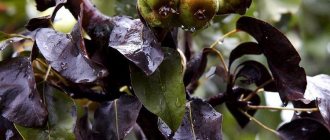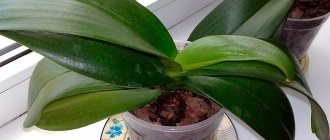Fungal diseases
Fungal diseases are most common on blackberries. In the initial stages, they are easy to cure, so you need to recognize their first signs.
| Septoria or White rot Septoria blight often appears during flowering. By the time the berries ripen, the disease becomes very noticeable. This is the most common reason why blackberries and berries dry out. Signs:
Prevention: White rot appears on blackberries due to high humidity, so monitor the moisture level in the soil, do not exceed 50–70%. Control measures:
| |
| Purple spot or Didimella Spot is a very common disease of garden blackberries and raspberries, which is difficult to notice in the early stages of development. Signs:
Prevention: The main reason is high humidity. The soil should not be over-moistened. Often, fungal spores live in plant debris, so fallen leaves and fruits must be removed from the garden or burned. Control measures:
| |
| Powdery mildew This disease often appears in early spring in warm regions and in summer in cool regions. Signs:
Prevention: Powdery mildew loves moisture and can “attack” through mechanical damage to the trunk. There is no need to over-moisten the soil; treat all “wounds” with garden varnish. Control measures:
|
The reasons why diseases appear in blackberries:
At the moment when the fruits ripen, high temperatures and direct sunlight can harm blackberries. The berries are the first to suffer from them. Their color begins to turn white and they begin to dry out. If the weather is hot outside for a long time, then the bush itself suffers. It stops getting enough fluid, burns appear on the leaves and stems, and eventually the weakened shoots dry out and die.
For this reason, in the southern regions, when choosing a place to plant blackberries, you should give preference to semi-shaded areas and regularly carry out watering activities using large amounts of water during especially hot periods.
Gardeners often wonder why the foliage begins to turn yellow in the spring. The cause may be bacterial cancer or yellow reticulum, however, often the cause is non-infectious chlorosis. This is caused by the fact that the plant experiences a shortage or, conversely, an excess of some element; the reason may also be stagnation of water in heavy soil.
Complex mineral fertilizers in liquid form can help avoid this.
The key to plant health and good yield is following agrotechnical rules.
The diseases listed above most often appear due to high humidity, thickening, lack of good ventilation, and the use of dirty tools when working with the bush.
blackberry diseases: photo
The best preventative measures for the plant are the following:
The correct choice of site, taking into account the plant’s needs for climate and soil. Of course, it is best to choose varieties that are highly resistant to diseases, winter cold and long periods of drought. Purchase seedlings only from trusted places and carefully inspect them before purchasing. If in any doubt, it is better to refuse the purchase. Planting should be carried out at a distance of 2 meters from each other. Pruning shoots in the spring and summer season so that there is no thickening and they can be well ventilated. Raspberry bushes, strawberries, and strawberries should be located as far as possible from blackberries. Regular weeding is a good preventative measure against the spread of diseases. The lower shoots, located at a height of 50 centimeters from the ground, bear very little fruit, but in contact with the ground they can get sick, so they need to be pruned. As soon as the entire harvest is harvested, all old shoots are cut off under the base and are burned. All fallen leaves and any other plant debris must be removed from the site in the autumn and with the onset of spring. Also loosen the soil, thus killing spores and microorganisms, mulch using humus for this. The bushes should be inspected regularly so that blackberry diseases or harmful insects can be detected at the initial stage and treated in time. All damaged areas must be removed and burned. Monitor so that the soil does not dry out and liquid does not stagnate in it. At the moment, there are many biological means with which you can treat plants without causing harm, so feel free to carry out prevention with them, but use chemicals only in case of urgent need.
Viral diseases
Viral diseases are the most dangerous; they can spread throughout the entire garden in just 1 week, infecting all plants. In the initial stages, the disease can be cured, but if the blackberry has been sick for a long time, it is better to uproot the damaged bushes and burn them.
| Ring spot This virus is spread by nematodes, small worms in the soil that attack the root system of plants. Ring spot is the answer to why blackberry leaves turn yellow. Signs:
Prevention:
Control measures:
| |
| Curly This disease usually affects plants that have been alive for several years. Curliness is one of the most common reasons why raspberries and blackberries dry out. Signs:
Prevention:
Control measures: In the initial stages of the disease:
|
Bacterial diseases of blackberries: stem and root cancer
The causative agent of the disease is the bacterium Agrobacterium tumefaciens, which lives in the soil. It is capable of infecting roots and shoots, on which lumpy growths are formed, brown on the outside and light on the inside.
Shoots stop developing, leaves turn yellow, root shoots grow thin and weakened. Yields fall, shoots lose resistance to drought and frost.
Since blackberries are infected with cancer through small wounds, it is necessary to be very careful during the planting process, trying not to damage the root system.
All diseased plants must be pruned and destroyed. The remaining blackberry bushes are treated twice with a 0.5% Fitolavin solution or a Pentafaga-S solution (200-400 ml per 10 liters of water).
Advice! You can try to save especially valuable varieties of blackberries affected by this disease if you carefully dig up the plants, clean them of cancerous growths, and then carefully cover the affected areas with a mixture of clay, mullein and 1% Pentafaga-S solution.
Pests and parasites
Blackberry pests spoil the roots of the plant and become carriers of dangerous viral diseases, so they need to be exterminated as soon as they are noticed.
| Western beetle or cockchafer This beetle overwinters in the soil and comes to the surface in late April-early May, hence its name. Appearance:
Signs:
| |
| Raspberry beetle Raspberries overwinter in the soil and emerge to the surface 15–20 days before the bushes begin to bloom. Appearance:
Signs:
| |
| Blackberry mite This insect usually appears in the spring, but cannot be seen with the naked eye. Appearance:
Signs:
|
Pests that damage flowers, berries and buds
The appearance of the berries remains the same, but the taste and yield deteriorate after exposure to pests.
Raspberry weevil
Grayish bugs with long proboscis bore holes in blackberry buds, laying eggs. The female gnaws off the peduncle under the bud so that the larva with it falls to the ground. The larva feeds in the bud for a month, then pupates, and already in July a generation of young beetles appears. The damage to one female per egg laying is 100 damaged peduncles.
The buds on the bushes are treated with karbofos before flowering; the second spraying is planned for the first days of August against the new generation of beetles.
Raspberry weevil
Raspberry bud moth
From the ground, caterpillars crawl up the shoot to eat young buds. Hatched insects make holes in the leaves, and females lay eggs in blackberry or raspberry inflorescences. The larvae eat away the receptacle, feeding on unripe drupes. The berries become smaller, deformed, and rot. The blackberries will also stop smelling. The bud moth descends to pupate. Its winter quarters are located 50 cm from the plantings.
In summer, beetles are shaken off bushes by covering them with plastic bags. Prevention is done by digging and mulching the soil.
Raspberry bud moth
Shaggy Bronzewort
A black bug with light spots on its back. With warming, it eats away the core of blackberry flowers, but not en masse. It is recommended to collect bronze beetles manually; in case of severe infestation, treat the plantings with insecticides such as Calypso.
Blackberry plantations often dry out due to high temperatures, and not due to attack by insect pests. Shrubs lose moisture, roots dry out, branches die, and fruits mummify. In hot weather, it is recommended to water the berry garden in the evenings and mulch the root zone.
Consideration of blackberry diseases and treatment of symptoms will be the key to powerful bushes that produce a harvest of juicy berries. Scrupulous adherence to the rules of agricultural technology will protect plantings from attack by pests, and preventive measures will reduce unpleasant symptoms to a minimum.
Remember
- Inspect the blackberry bushes . If you notice the first signs of the disease, it is much easier to cure it in the initial stages.
- Monitor soil moisture . Too high or low humidity can cause serious fungal diseases.
- Eliminate pests. They weaken plants and make them susceptible to disease. Insects carry dangerous viral diseases.
- Burn infected parts of the plant. As well as fallen fruits and leaves - they contain fungal spores, which begin activity at warm air temperatures.
Video: treating blackberries from insect pests.
Fungal diseases
The most common diseases among cultivated plants. The fungus can penetrate through wounds, sunburn and damage caused by insects.
- Rust. Because of this disease, the leaves on the blackberry bush completely fall off in midsummer. And the stem of the diseased plant will become brown with light sores. Over time, they will become cracked, and the stems themselves will dry out. To destroy rust fungus spores, young leaves should be treated with a fungicide twice with an interval of 20 days.
Blackberry diseases and pests
Diseases and pests of blackberries. Signs of fertilizer shortage.
Cottage, garden and plot » Encyclopedia of garden plants » Diseases and pests of blackberries. Signs of fertilizer shortage. Part 3. What blackberry bushes look like if they lack minerals. Pests and diseases.
Blackberries - diseases and pests As already noted, blackberries are a close relative of raspberries. Having been neighbors for many centuries, they have common diseases and pests, the control measures for which are very similar in these crops. Infectious fungal diseases of blackberries:
Classification of blackberry diseases
Like most representatives of the plant kingdom, all possible diseases of garden blackberries are divided into four main groups:
- Non-infectious - caused by various unfavorable weather conditions and errors in care.
- Fungal - caused by fungal microorganisms, whose spores can travel in all unimaginable ways: with the help of wind, rain, pests, on tools, clothing and, of course, on various plant organs.
- Bacterial - caused by dangerous bacteria that live mainly in the soil.
- Viral - caused by viruses, which can spread in various ways, but are most often transmitted through insect pests.
In general, insect pests play a significant role in the spread of diseases on blackberries, but more details about blackberry pests and methods of controlling them can be found in the article posted in another section.
Western May beetle (Melolonthamelolontha L)
In the spring, blackberries begin a rapid period of growth and flowering. Khrushchev finds berry plants and infects them, which can cause violent falling of leaves, ovaries, and flowers.
Even greater damage occurs from the larvae of the cockchafer, which damage the roots of the plant by gnawing them.
For the winter, adults hide in the soil. And in the spring there comes a fertile time for them, a massive summer of the cockchafer, especially when the plants bloom profusely. During this period, leaves become the main source of food for blackberry pests. Large clutches of larvae can also be found in the soil, at a depth of approximately 40 cm.
It takes about three years for the pest larvae to fully develop. All this time they feed on humus, causing damage to the roots, which is why the plants begin to wither very quickly and then die. By the summer of the fourth year, beetle larvae begin to pupate at a depth of 60 cm. And after another 40 days, beetles will hatch from them, which will remain in the soil until next spring.
- If you are just going to plant blackberry bushes, then a preventative measure to combat blackberry would be to soak the roots of the seedlings for 30 minutes in a 0.65 Aktara solution.
- The drugs Antikhrushch and Konfidor are quite effective during the growing season. It is enough to treat the soil around the bushes with solutions and water them.
- Some gardeners successfully use iodine against beetleworm. Iodine solution - 20-25 drops per bucket of water - water the plants at the roots.
- Sowing green manure such as mustard between the rows of blackberries is of great benefit. The mustard root secretions are not to the liking of the beetles, they leave this place.
- Starlings are a good help in fighting Khrushchev. Don't be lazy, hang birdhouses around the garden. The starlings will destroy all the cockchafers, which means there will soon be no beetles. True, starlings are not averse to eating cherries, but it’s up to you to choose what is more expensive.
↑
Viral:
Plant bacteria cause viral diseases of blackberries. Gardeners have not found effective methods to combat them. It is recommended to remove wild shoots of wild species closer than 20 meters from the berry garden and plant the area with healthy seedlings.
Yellow mesh
Yellow reticulation is recognized by reticular chlorosis. The disease appears as vague yellowish spots along the veins of the leaves. The main veins are colored yellowish-green, spreading out like a fan. During the growing season, yellowness affects the entire plant, weakening the growth of shoots. The carrier of the netfrequency is the raspberry shoot aphid.
Mosaic
The leaves of the plant are covered with mosaic spots of yellowish-greenish color. As yellowing progresses, the affected areas become convex and wrinkled. The virus weakens the plantings, the branches stop growing. The mosaic penetrates the tissue, preventing the bush from preparing for winter. As a result, it will not survive the winter. The virus is transmitted by shoot and raspberry leaf aphids.
Ring spot
Infection occurs through small nematode worms that live in the soil layer. The virus infects the plant, appearing as vague yellow spots on the leaves. Clearly yellowed blackberry leaves are visible in spring or autumn; in summer they cannot be seen. The plant produces weakened branches that quickly break.
Curly
Curly leaves enter the territory along with infected planting material. The disease is transmitted by nematodes that extract the juices from the seedling. The disease is recognized by twisted, deformed leaves. The plate is initially dark green in color, later acquiring a bronze tint. The internodes are shortened, and secondary leaves sprout from the veins. Ugly flowers appear and the ovary does not form. Curl affects two-year-old specimens.
Raspberry leaf curl
Treatment methods
There is no treatment for viral diseases. It is recommended to take preventive measures:
- If blackberry branches dry out, blackberry pests cause the bushes to weaken. Nematodes, aphids and other insects carry viruses into cracks in branches and roots, feeding on plant juices.
- They turn to certified horticultural nurseries for planting material.
- Spraying with Pentafag solution with antiviral effect is carried out 3 times during the growing season.
The key to a viable blackberry is proven planting material. Cheap seedlings from the market will be a disappointment for the gardener and will infect other fruit crops with viral infections.
Raspberry beetle (Byturustomentosus F)
This pest is capable of causing widespread damage to the entire plant, damaging everything from leaves, inflorescences to stems and roots. The insect, 4 cm in size, has a grayish-black color, densely covered with yellow-rusty, dirty gray hairs.
The beetles go into the soil for the winter, and in the spring they come out and begin to eat the flowers of gooseberries, blackberries, currants, and many fruit trees. But these pests give preference to raspberries and blackberries.
Beetles can eat away leaves heavily, leaving behind holes on foliage, flowers, and buds. The berries can also be affected, and rot quickly forms on them.
Eggs are laid in flowers or fresh ovaries. This is an excellent breeding ground for pest larvae. As the larvae develop, they fall to the soil and remain there until pupation. In autumn, the pupae turn into beetles, which also prefer to overwinter in the soil without appearing on the surface for a long time. Some of the larvae remain there until pupation until the following spring.
- To prevent the spread of the raspberry beetle, dig up the soil under the bushes in late autumn or early spring. Gardeners advise dusting the dug soil with tobacco dust or ash.
- You cannot leave rotten berries on the bushes.
- When buds appear, about a week before the flowers bloom, spray the blackberries with solutions of actellik, spark, kemifos, fufagon, kinmiks. You can alternate these solutions.
↑
Classification
Since raspberries and blackberries are closely related, they develop the same diseases. Due to excessive damage to plants by diseases, the bushes begin to weaken, the condition of the soil deteriorates, and the planting material dies.
It is customary to divide blackberry diseases into four groups:
- bacterial – microorganisms that live in the soil are the causative agents of various pathologies in plants;
- viral - the name speaks for itself, the main source is considered to be viruses, often spread by insect pests that transfer the disease from one crop to another, which becomes a fundamental factor in the large-scale infection of most garden and berry varieties;
- fungal - parasitic bacteria that have spores that fall on plants with the help of pests, wind, rain, and are also carried on clothes, tools, and the like;
- non-infectious - occur due to exposure to bad weather conditions or non-compliance with agricultural practices.
It is necessary to familiarize yourself in detail with the ailments that negatively affect blackberries, which is why they lose the positive properties originally declared by breeders.
Hairy deer or hairy bronze deer (Epicometishirta poda)
The beetle does not look very remarkable in appearance. The insect is black in color with white dots on the wing flaps. The hairy Olenka beetle is covered with thick gray-yellow hairs.
The pest waits out the winter in the soil and comes out in early spring. The insect chooses flowers and blackberry petals as its food source.
The greatest activity of the pest is observed with the onset of sunny days, when it is warm - this is from 10 a.m. to 4 p.m. In damp, cloudy weather, or at night, the beetles do not stay on the plants, but go deep into the soil or burrow under a layer of plant media.
Eggs are laid in the soil at a depth of up to 4 cm. Humus and plant residues are sufficient for the larvae's nutrient medium. Pupation occurs approximately in the middle of summer, and already in the 2nd-3rd ten days of September all the pupae come out, becoming beetles.
Adults prefer to spend the winter in the soil; they can only be discovered next spring.
- According to gardeners, an excellent remedy against hairy deer is the Calypso insecticide. The solution of this drug effectively destroys the pest on other plants and flowers.
- One cannot ignore the physical method of destroying Olenka furry. Pests are shaken off bushes, tree branches, flowers onto the litter, poured with kerosene, and burned.
↑
Blackberry root pests
For the inhabitants of the upper layers of soil in the garden, food must be obtained by making tunnels. When insect larvae reach the roots of plants such as blackberries, they begin to parasitize them. Therefore, to save the culture, timely control of insects and their larvae is necessary.
Medvedka
A large insect with strong legs gnaws at the roots of a blackberry. After this, the bush begins to dry out. It is necessary to determine the cause of the disease. To do this, the soil is raked away from the roots to identify the pest. The parasite's burrows are filled with water and ammonia or soap solution. Manure and straw are used for bait, filling the holes with it. Mole crickets will build nests in them, and then you can scatter organic material and destroy the insect.
Chafer
The larvae of the May beetle, or beetle, feed on the leaves and roots of blackberries. You can destroy the larvae by digging up a bush and placing the root in a mash of clay and tobacco dust. In May, water the bushes with water with a few drops of iodine.
Parasitic on leaves
If blackberry leaves are deformed, you must carefully inspect them for pests. Having seen colonies of insects, you can manually collect them or tear off the affected leaves.
See also
Description and characteristics of blackberries of the Thornless Evergreen variety, propagation, planting and careRead
Raspberry leaf sawfly
Pests are leaf-boring, as their larvae destroy leaves first in the lower part of the bush, then rise up. Pseudo-caterpillars spend the winter in cocoons, hiding in fallen leaves.
If you do not fight the sawfly, the bushes will soon be left without greenery . To protect the berry plantings from pest attacks, it is necessary to dig up the soil around the plants. He doesn’t like it when they spray it with infusions of garlic and tobacco.
Blackberry aphid
This type of aphid is large in size. It has dark patterns on its yellowish back. Aphid colonies parasitize the underside of the leaf. They are combated by spraying with insecticides and folk remedies.
Raspberry leaf aphid
In the spring, when the blackberry leaves become ugly and covered with sticky secretions, plants of the aphid family begin to suck out the juices. In summer, a huge number of small pests are visible on the shoots. From them the plant becomes infected with fungal infections and viral diseases. Among the drugs used to combat aphids are “Confidor” or “Fitoverm”.
Common spider mite
A small spider with four pairs of legs is visible only with a magnifying glass. But it does enormous harm to the berry crop. It settles on the underside of the leaves, sucking out the juices and entwining everything with a thin web. Because of this, the leaves begin to turn brown and die. After fertilization, females find refuge in fallen leaves and lumps of earth.
The pest can be prevented by cleaning and burning garbage in the fall, digging up the soil, and fumigating with sulfur.
Raspberry hair mite
A web entangling the shoots, leaves and berries of blackberries indicates mite damage to the plant. White dots are found at the bottom of the plate. The leaves begin to become deformed, and the plant lags behind in development.
Stem raspberry gall midge (Lasiopterarubi Heeg)
This pest of blackberries and raspberries has a small body - no more than 2 mm. Beetles with transparent wings are black, have a brown back, and are covered with yellowish hairs.
The massive insect flight begins in mid-summer, just when blackberries bloom profusely. A clutch of pest eggs can be found in young shoots. First, tiny, legless larvae penetrate into the bark of the shoots to obtain a favorable nutrient environment there.
In affected plants, the stems are covered with galls - formations in the form of swellings. There, the beetle larvae remain over the winter, and in the spring they pupate, becoming beetles, which, with the onset of the flowering period, lay eggs again.
Due to the development of gall midges, plant growth stops significantly. An irreversible process begins, associated with the complete death of the plant.
Measures to combat gall midge are described in detail in the article “Gall midge on raspberries, how to fight.” The methods of combating galitsa on blackberries and raspberries are the same.
Non-communicable diseases
Non-infectious diseases of blackberries appear due to gaps in the knowledge of the novice gardener. Violation of the rules for planting seedlings and a lack of fertilizers provoke the appearance of signs reminiscent of a fungal or viral infection. The reasons for drying out are not disease, but the planting of the berry plant in poor soil.
| Item name | Signs of shortage |
| Nitrogen | Weakened, brittle shoots grow, the leaves are covered with spots reminiscent of chlorosis infection. Grinding drupes. |
| Bor | Curling and falling of plates. The death of the apical buds, the growth of the lower tier. Flowering and berry set are weak. |
| Iron | Chlorosis damage. The appearance of yellowish areas on the leaves. Ugly drupes become knotted and die. |
| Potassium | Curlyness of the plates, along the edges of which a brown rim appears. Softening the berries inside. |
| Calcium | Young leaves begin to turn yellow, old leaves remain unchanged. Dying of apical buds and shoots, decay of the ovary. |
| Magnesium | The plates may turn red and the veins turn green. Leaf fall begins from the lower tier. |
| Manganese | The leaves turn yellow, then turn brown. |
| Molybdenum | Curling leaves inward. The veins become pale, the remaining parts remain unchanged. |
| Copper | Slow growth of shoots. The plant gains volume due to the development of axillary buds. The berries have almost no seeds. |
| Phosphorus | Poor growth of green mass. The leaves turn bronze and then fall off. |
| Zinc | Asymmetry of thickened yellowed plates. Small deformed drupes. |
The foliage begins to turn red in mid-summer - a sign of soil acidity. Liming is carried out to neutralize the soil, wood ash and complex fertilizer are added to feed weakened shrubs.
Targeted feeding with the missing microelement will be the key to healing shrubs from red or yellow spots on the leaves. An excess of microelements is also destructive; act strictly according to the instructions.
Raspberry stem fly (Chortophiladentiens Pand)
This is a fairly common pest of blackberries and raspberries. When insects appear, they begin to damage the stems of young plants. The pest is dark in color, with a characteristically protruding “forehead”. Adult beetles can reach up to 7 mm in length. The larvae of the pest are white, worm-like in shape, up to 5 mm in size.
For the winter, beetles go into the soil to a depth of 6 cm, and they can also be found in thick grass or under bushes. For pupation, it is enough for the air to warm up to +13 degrees. And after another ten days, the mass emergence of adult insects begins.
Pests settle on plant stems, destroying shoots. Eggs are laid in the area of flowers, the tops of young shoots, as well as in the axils of leaves that have not had time to open.
The larvae, once in the nutrient medium, begin to actively develop and gnaw through the shoots. First, they make tunnels for themselves there, then they descend deep into the stem to stay there for the winter. A yearly cycle is enough for one generation of pests to appear.
- Chemical agents for controlling raspberry stem fly are ineffective. Experts advise trimming drooping blackberry shoots as soon as wilting is noticed. This is the only way to block the fly from descending inside the shoot to pupate in the ground.
- Cut shoots must be burned.
Pests of blackberry shoots:
Regular inspections of plantings lead to the detection of microscopic pests. They cut off the affected parts of the shoots, burn the fallen leaves, and treat the bushes with protective agents.
Raspberry stem fly
The fly lays eggs in the tips of the shoots of seedlings. The hatched light larvae gnaw inside, causing the stem to wither. If you do not cut the branch, the pest will reach the ground, where it will pupate for the winter.
They recognize the infection by drooping shoots. The affected stems are cut out and removed from the area for destruction. Mulching will protect against the emergence of raspberry flies in the spring.
Raspberry stem fly
Raspberry shoot aphid
Shoot aphids colonize the tops of shoots near the buds, drawing out juices. Then it moves on to petioles, inflorescences, and fruits. In the summer, females lay larvae instead of eggs, switching to viviparity. This property allows you to increase the colony and intensively occupy plantings. At the first signs of infection, the affected areas of the bush are cut off for burning. Treatment with Actofit or Fitoverm will help destroy aphids.
Raspberry stem gall midge
Pest larvae live in galls - growths on stems. They feed on plant juices, preparing to pupate for winter. On warm days, pupae emerge and develop into adult orange-yellow gall midges. In places where larvae are found in large numbers, the shoots break, thereby damaging part of the plantings. In early spring, the shoots are inspected to cut and destroy damaged branches.
Raspberry stem gall midge
Blackberry mite (Acalitus essigi)
The tick is so small that sometimes you may not notice it right away. The insect has an elongated shape, like a worm.
For the winter, pests do not go underground, but remain inside the plant buds, choosing blackberries. With the onset of warmth, insects migrate to the shoots, and then, during vigorous flowering, to the inflorescences and berries.
It is in the berries that the blackberry mite finds an excellent breeding ground. He simultaneously eats and introduces substances into the berries that affect their quality. Because of this, blackberries cannot fully ripen. The appearance of the plant and the taste of the berries deteriorate, which are no longer suitable for sale.
Blackberries affected by mites do not darken when ripe; they either remain completely or partially red.
The blackberry mite can destroy up to 50 percent of the crop.
To prevent the introduction of mites inside the flowers, the berries should be sprayed with solutions of Envidor, Tiovit Jet, Bi-58 in the spring before the buds open.
Methods for combating fungal diseases of blackberries
Gardeners use a proven method of treating the garden with Bordeaux mixture. Biological preparations that are harmless to health are considered a new method. Such substances consist of strains of bacteria, which, after exposure to fungal infection, disintegrate in the soil into safe compounds.
Fighting fungi:
- Plants are treated with Trichodermin solution after bud break, repeating spraying after 10 days.
- Treatment with Topsin M and Topaz is carried out twice per season.
- The effect of Kuproxat or Oxychome is manifested when blackberries are processed before the flowers bloom.
- Stems that are allowed to overwinter are treated prophylactically with Farmayod.
- Prepare garlic infusion. In 3 liters of water, infuse 300 g of garlic pulp for a day, filter through cheesecloth, and dilute it 20 times the volume. The berry garden is processed in the evening before sunset.
Trichodermin solution for plant protection
Regular inspection of blackberries will save future harvests. When spots appear on shoots and leaves, cut off the damaged parts and take them outside the plot for burning. Treatment begins with traditional methods, but in case of mass damage they switch to chemicals.
Common spider mite (Tetranychusurticae Koch)
Spider mites have a size of up to 0.4 mm. The pest chooses flowers, leaves, stems of blackberries, currants, and other fruit crops as a nutrient medium. For fertilization and wintering, the tick chooses fallen leaves, plant debris, and the bark of standard trees.
When the air warms up to 12 degrees in spring, insects crawl out of their shelters and move onto the leaves, remaining on their back side. The plant below begins to become covered with a thin web.
During the flowering period, the mite is capable of breeding up to 12 generations. At the same time, the leaves of the plants begin to wither greatly, turn yellow, and fall off by mid-summer.
Mites cause the main damage to plant stems - by piercing the epidermis and sucking out the cell sap of leaves. This process can be detected by the appearance of the leaves; formations appear on them - white spots. Severely damaged leaves stop photosynthesis and their green pigment and moisture disappear.
As a result of damage to the plant by the common mite, the yield decreases and the ability of the blackberry to resist disease deteriorates.
- In early spring, you should collect all last year's leaves under the blackberry bushes and burn them, as overwintering mites may remain there.
- Treatment against spider mites should begin when the buds hatch and the first green leaves appear. You can treat plants with preparations of biological origin (Fitoverm, Actofit, others) or chemical ones - Tiovit Jet, Bi-58, etc. The preparations can be alternated.
- The number of treatments is at least 3, the frequency is 7-10 days.
Basic methods of struggle
In order for prevention to be effective and treatment to lead to rapid recovery of plants, it is necessary to follow the dosage specified in the instructions for the chemical preparation or folk remedy.
Did you know? People learned about the benefits of blackberries about 2 thousand years ago. The first mention of the beneficial effects of berries on humans is contained in the works of the ancient Roman physician Dioscorides.
Fungicides and insecticides
The following drugs are used to treat diseases of berry bushes:
- "Fundazol". A drug with a fungicidal effect, used for the prevention and treatment of many fungal diseases. Usage rates: 10 g / 8–10 l of water / 1.4 acres.
- "Kuproksat". Copper fungicide. The working solution is prepared from 70 ml per sprayer tank. This amount is used to process one hundred square meters.
- "Teldor." Low-toxic systemic fungicide. Usage rates: 8 g/5 l/1 weave.
- "Topaz". A reliable remedy against powdery mildew. 9 ml must be diluted in a bucket of water. 1.5–2 liters of liquid are consumed per bush.
- "Strobe." To combat powdery mildew, dissolve 2 g of the product in 10 liters of water. Used for spraying during the growing season. The recommended number of treatments is 2.
- "Skor." Used for spraying vegetative plants in an amount of 2 ml/10 l/2–5 acres.
- "Pentaphage". Recommended consumption rates against bacterial viruses are 200–400 ml/10 l. Used for irrigation - 2-3 l/bush. For spraying, prepare a solution of 100 ml/10 l. Consumption - 5 l/ha.
- "Abiga Peak". The solution is prepared as follows: the bottle is diluted with 1 liter of water, brought to a volume of 10 liters. This quantity is calculated per hundred.
- Copper sulfate. Antiseptic and fungicide. Product consumption: 50–100 g / 10 l, 1.5 l/bush.
- Bordeaux mixture. One of the most popular fungicides among gardeners, effectively acting on diseases caused by fungi. For prevention, a 1% composition is used: 100 g of copper sulfate, diluted in 5 liters of water + 200 g of quicklime, diluted in 5 liters of water. For treatment, a 2% and 3% mixture is used (the number of components is increased by 2 and 3 times, respectively).
To prevent attacks by harmful insects, as well as to expel them from the garden plot, the following insecticides and acaricides are used:
- "Metaphos". Shows insecticidal and acaricidal effects against insects that spoil leaves and suck out juices. Dilution method: 10 ml of substance per 10 liters of water.
- "Medvetox". To combat mole crickets, the product is applied to the ground to a depth of 3–5 cm in an amount of 20 g / 10 m².
- "Medvecide." Bait for mole crickets, ants and beetles. Directions for use: dig holes 2-3 cm deep, at a distance of 0.5-1 m from each other, pour 2-5 g of the product into them.
- "Aktara". A product with an insecticidal effect. To prepare the working solution, mix 1 packet per 10 liters of water. Consumption - 2 liters per bush.
- "Bazudin Extra". Insecticide against above-ground and underground harmful insects. Prepared by diluting the sachet in a bucket of water.
- "Anti-Khrushch." Insectoacaricide. The working solution is prepared from 10 ml, dissolved in 5 liters of water. This amount is enough to cultivate a plot of 0.2 acres.
- "Karbofos" . Effective against many insects. Diluted according to the 60 g / 8 l scheme. Consumption - 1–1.5 l/bush.
- "Fufanon." An insecticidal preparation with a broad spectrum of action. Effectively acts on pests that gnaw and suck juices from the plant. Directions for use: 10 ml/10 l. Consumption - 2 liters per 10 bushes. The maximum number of sprays per season is 2.
- "Fitoverm". Biological agent acting as an insecticide and acaricide. Requires 2 treatments with a break of 2-3 weeks. Recommended dosage is 1 ampoule per bucket of water.
- "Spark". Has a detrimental effect on more than 60 species of insects. Available in tablets. Method of preparation: dissolve the tablet in a small amount of water, bring to a volume of 10 liters. Consumption - 1.5 l / 10 m².
- "Aktellik". Insecticide-acaricide. The ampoule dissolves in 8 liters of water. The product is sprayed using a garden sprayer.
- "Wofatox." The drug has an insecticidal effect on pests living in the soil. It is added to specially prepared crumbly cereal porridge in the amount of 20 ml / 1 kg of porridge. They insist for half an hour.
- "Nitrafen". Insecto-, fungi-, acaricide. For spraying, prepare a 3% solution: 300 g/10 l. For 10 m² of planting, use 1.5–2.5 liters of solution.
Folk remedies
Among the folk remedies used to prevent diseases:
- Soda solution . Method of preparation: 4 tbsp. l. dissolve in 10 liters of warm water. Use for spraying leaves.
- Infusion of onion peel . It is prepared from 2 glasses of husks, which are placed in 2 liters of water. Duration of infusion - 2 days.
- Soap solution . It is prepared from 300 g of grated laundry soap. The shavings are placed in 2 liters of warm water, dissolved by stirring, and brought to a volume of 10 liters. You can also dissolve 300 ml of liquid soap in a bucket of water.
- Tansy infusion. Method of preparation: place 2 kg of fresh (700 g dry) herbs in 10 liters of water, leave for 2 days, boil for 30 minutes, add soap, dilute with cold water in a ratio of 1 to 2.
How blackberry diseases manifest themselves and how to combat them
Knowing what blackberry diseases there are, you can grow a beautiful and healthy plant. Berries picked on your own plot are the most delicious. Many people prefer dark and large fruits. To achieve the desired result, it is important to recognize the problem in time, determine what exactly is causing it and promptly begin treating the garden crop.
On the shoots of a bush
Shoot damage is difficult to find because the insects are as microscopic as the damage they cause. But from them, blackberry bushes can become infected with pathogenic viruses and fungi that penetrate into plant tissues.
Raspberry moth
A small hymenopteran insect with its pathogenic action causes the growth of elongated swellings on the shoots, galls. After this, the berry plant begins to dry out and stops developing. As soon as they discover swellings on the branches, they try to cut them off and treat the affected areas with Actellik.
Raspberry shoot aphid
The buds on the tops of the shoots are affected by shoot aphids. Having saturated with juices from the branches, the parasite hastens to destroy the inflorescences and petioles, then moving on to the fruits. Insect colonies increase several times during the season, threatening to destroy the entire blackberry bush. To eliminate the pest, it is necessary to cut out shoots infected with the parasite, and spray the bush with a preparation such as Fitoverm.
Raspberry stem fly
Flies with transparent wings circle over blackberry bushes, laying eggs. The emerging larvae bite into the tissues, making passages inside the stems. This results in wilting of the berry crop with sagging branches. To prevent the fly from flying out, in early spring the soil around the bushes is mulched with a layer of compost or humus.
Raspberry shoot gall midge
Feeding on the juices of the blackberry plant, the fly larvae hide in special growths, galls. After pupation, after some time they transform into adult gall midges. The color of the adult is interesting: a long body with orange stripes rests on high legs. The habitats of the larvae are dangerous, as cracking of the shoots occurs here and they begin to break.
You can prevent pest attacks by carefully inspecting the bushes and cutting out weakened and diseased shoots.
On buds, flowers, buds and berries
Blackberries are valued for their tasty and healthy berries, and when the fruits do not appear, this is due to either diseases or pests. Among the harmful insects there are many that are not averse to eating black drupes. Then it becomes clear why the berries dry out.
Raspberry bud moth
A delicacy for the parasite are young buds, as well as buds of inflorescences and ovaries. The insect prevents black berries from developing. They do not reach ripeness, they immediately begin to deform and become tough. You can get rid of butterflies by shaking off adults from bushes. After collecting the pests on a plastic bag, they are burned.
Flower beetle
This is the name of a bug with a body length of 3 millimeters, gray and black in color. After gnawing the peduncle, the female lays eggs there. And after hatching, the larvae begin to eat blackberry flowers. You can get rid of the pest by collecting insects by hand or by spraying with Wofatox, a solution of wood ash.
Main blackberry diseases
Most often, the plant is affected by pathogenic fungi. They are the causes of almost 80% of bush diseases.
Yellow blackberries indicate the development of dangerous diseases, the treatment of which must be started immediately.
The most common blackberry diseases:
- rust;
- purple spot;
- anthracnose;
- septoria.
The natural habitat of mushrooms is soil. They spread easily by wind and rain. The source of infection can be untreated equipment or new seedlings. The infection quickly penetrates through damage to any parts of the plant during transplantation. The spreaders of diseases are insects that live on blackberries and a lack of minerals or vitamins.
To find out why blackberries dry out, you should carefully examine the leaves. The color change will tell you which vitamin is missing.
List of substances and signs of their deficiency in plants:
- Iron. Lack of the element is the first reason why blackberries dry out. The leaves turn yellow and the veins turn pale.
- Nitrogen. All parts of the plant are weaker: the leaves become smaller, become yellowish and brittle, the blackberry blooms poorly and bears small berries.
- Potassium. The formed plates have a brown border; when ripe, the berries become very soft in the middle. Often yellow leaves on blackberries are observed in the spring.
- Calcium. The upper buds, without blooming, die off, and the young foliage turns yellow.
- Magnesium. The leaf blades acquire an uncharacteristic shade - red or purple, transparent areas are visible on them, the plant sheds them early.
- Phosphorus. The leaves bloom with a delay, quickly darken, turn black and dry out.
- Copper. The shoots do not want to grow, the tops of the bush disappear, the edge of the leaf turns white.
- Bor. Small, deformed and twisted leaves that quickly fall off, causing corky depressions to form in the berries.
- Zinc. Thickened and small leaves on the tops of bushes.
- Manganese. Patterns appear on the leaves, the plates turn yellow and fall off.
- Molybdenum. Light spots on new leaves that quickly dry out and curl.
Non-communicable diseases
They arise not due to a pathogenic infection, but against the background of growing in depleted or too saturated soil. Such problems are difficult to identify in the early stages; visible signs appear only with prolonged exposure to a deficiency or surplus of minerals in the soil.
Symptoms indicating an unbalanced content of macro- and microelements:
- Iron . With its deficiency, blackberry leaves turn yellow, the berries dry out and become deformed. The plant stops growing, as metabolic processes are disrupted. The bush weakens and does not tolerate temperature changes. This problem can be eliminated by adding ferrous sulfate.
- Potassium . The need for this element can be determined by the characteristic red-brown spots on the leaves. Outwardly, it resembles a sunburn, but gradually acquires a gray tint and curling occurs. The berries dry out and fall off without having time to ripen. For prevention during autumn and spring fertilizing, you can add potassium sulfate at the rate of 70 g per 1 m2. If the problem occurs during the season, you need to additionally fertilize the soil.
- Nitrogen . Leads to curling, deformation and falling of leaves. The processes of growth and fruiting first slow down and then stop. The leaves turn yellow and look weak. The only method to avoid nitrogen deficiency is the application of mineral or organic fertilizers during scheduled feeding.
- Bor . With a deficiency of this element, the leaves become small, curl and fall off. The plant practically does not bloom, the berries do not have time to ripen on time. During flowering, it is recommended to apply boric acid once, 2 g per 1 m2. Excess boron in the soil can lead to the appearance of brown-red burns on the edges of leaves.
- Calcium . With its deficiency, the apical bud dries out. Young shoots do not develop and gradually turn yellow. The growth of the root system slows down significantly. You can normalize the amount of calcium in the soil by adding organic matter or complex mineral fertilizers.
- Magnesium . The main sign of deficiency is reddening of leaf blades and slow growth of fruit branches. If there is an excess, the leaves turn dark brown and then die. To replenish the microelement in the substrate, dolomite flour or the addition of magnesium sulfate at 45-50 g per square meter is used. meter.
- Manganese . Manganese deficiency is common and results in a patterned pattern on the leaves. At first it has a light yellow tint, then darkens and leads to massive leaf loss. If a problem is detected, it is recommended to spray the soil with a 1% solution of potassium permanganate.
- Copper . Occurs when blackberries are grown in peat and clay areas. Deficiency leads to the appearance of white spots on the tips of leaves, and the growth of young shoots slows down. The shrub's frost resistance decreases and its growth buds die off. Copper is found in some fungicides and complex fertilizers for berry crops.
- Zinc . The lack of this mineral in the soil can be determined by the yellowing of the tips of the shoots. The leaves are formed in an asymmetrical shape, with a bronze tint appearing on the surface. The berries do not ripen, which reduces the planting yield. With a surplus of zinc, the leaf veins become red-black and the apical buds disappear.
An effective method to avoid changes in the composition of the substrate is to adhere to a scheduled feeding regime throughout the season. It is important to choose the place for planting wisely, as this directly affects the quality of fruiting and development of blackberries.
Anthracnose is a disease that destroys crops
This is a common blackberry disease that requires effort to control. The disease is caused by the fungus Gloeosporium venetum Speg. It attacks plants in late spring or early summer. Frequent rains and overzealous watering contribute to this.
This fungus thrives in regions with cool and humid climates. For example, in the northern part of Belarus, Russia and Ukraine. The infection affects all parts of the plant located above the ground.
The disease can be identified by gray sores. The berries of such blackberries ripen slowly and gradually dry out. Most often, while still green, they bend and fall off.
When affected by fungus, castings become smaller and become covered with spots (gray or with a purple outline). Then, at the site of the inclusions, lunges form, it seems that insects have settled on the plant. The spots are usually located near large veins and along the edges of the plates.
Other diseases
There are pathologies in blackberries, the cause of which is difficult to explain. Although they are not very common, you need to have an idea about them.
Overgrowth, or dwarfism
Similar to brooms sticking out of the ground - this is what berry bushes look like when they are infected with single-celled mycoplasmas. The disease occurs when plants are weakened after winter and some of their shoots are frozen. It is difficult for berries to recover even after a long drought. When such “shorties” decorate a garden plot, it is clear that a sick blackberry cannot be resurrected. It must be dug up and burned. It is better to spray the remaining bushes with Fundazol.
Root system pests
The inhabitants of the upper soil layers make moves, gnawing the roots of plantings along the way. These include insect pests or their larvae. Blackberry plantations attract people with their thin, juicy roots and green shoots.
Medvedka
When there is an excess of humus in the soil, mole crickets appear - insects with strong paws and jaws that break through numerous underground passages. Wilting of plantings is evidence of the vital activity of a pest that chews off young roots.
Near the drooping seedling, they loosen the ground in search of a hole leading to an insect hole:
- Shake 3 tbsp in a bucket of water. l. ammonia. Pour the solution under the bushes.
- Pour soapy water and washing powder into the hole. The mole cricket will crawl out, where it must be destroyed.
- Mix Medvecid, Boverin or Medvetox powder with the soil.
In the fall they make bait for insects. They dig holes where manure and straw are placed. The mole cricket settles in a trap for the winter, and with the onset of cold weather, the contents of the hole are scattered on the ground. When exposed to sub-zero temperatures, the pest dies.
Mole cricket pest
May beetle (chafer larva)
May beetles eat all parts of young plantings, but the larvae of the pest are considered dangerous. Massive contamination of the soil leads to the loss of the plantation:
- With a small berry plot in cloudy weather, dig up each bush, shaking off harmful larvae. The roots are dipped into a clay mash with tobacco dust.
- The root system of seedlings is treated before planting in Aktara solution. The insecticide penetrates the plant, turning into poison.
- On May days, the bushes are watered with a bucket of water with 25 drops of iodine dissolved.
A year before planting the crop, the area is sown with mustard, alfalfa or clover. Green manure secretes a specific substance that repels insects.
May beetle leaves its larvae on the leaves of bushes
How to avoid diseases
One of the mandatory procedures for caring for blackberries
To keep the bush healthy and enjoy delicious berries, you must follow preventive measures:
- promptly notice lesions and destroy them;
- weed beds and paths from weeds - dangerous carriers of diseases;
- when planting, leave a large space between the bushes;
- do not allow the soil to become waterlogged;
- trim the bushes in a timely manner, removing old shoots;
- make sure that the bed is well ventilated.
In the spring season, 90% of diseases can be prevented and all pests can be removed. The main thing is not to postpone all important procedures until it gets warmer and insects become more active.
Causes of diseases
Large berries can only be obtained with proper care of the bushes
Poor soil can be the culprit of berry crop disease. If the soil is too acidic or contains a large amount of clay, the blackberry will definitely get sick without proper care. Weeds growing in rows and paths are also carriers.
Anthracnose
This fungal disease is most common in warm areas with high humidity. It appears in the form of purple spots on the shoots of raspberries and blackberries. At first the spots are small, then they grow, become purple-gray and spread to the leaves. The bark of the plant gradually turns gray, and the leaves die off. On berries, anthracnose also appears in the form of purple spots, the fruits become dry and tasteless.
Control measures
- All affected shoots must be removed, the soil loosened and treated with fungicides (Agrolekar, Chistoflor, copper oxychloride).
- When planting seedlings, it is important to choose only healthy planting material.
- Plantings should not be allowed to become dense; weeds must be constantly pulled out.
- As a preventive measure, in spring and early summer, raspberry bushes should be sprayed with a 1% solution of Bordeaux mixture or a 0.5% solution of copper oxychloride.
- The drug Prognosis has also proven itself well. 1 ml of the product is dissolved in 1 liter of water and the resulting solution is sprayed on the bushes 3-4 times per season with an interval of 7-10 days.
Ring spot
This viral disease is characterized by curling of leaves and the formation of yellow spots on them. The ringspot virus spreads very slowly throughout the garden. But it is dangerous because yellow spots on the leaf blades are visible only in spring and autumn. In summer you may not notice them.
Curled leaves become thin, brittle and easily break from touch or wind. Plants affected by this virus develop poorly and often die.
Control measures
- The virus is spread by nematodes, which can live in the soil and develop on the roots of many other plants, so crop rotation will not help the situation. If more than 20 nematodes are found in 500 g of soil, then the substrate should be treated with nematicides.
- It is not recommended to plant raspberries and blackberries in a place where there used to be beds of strawberries, cabbage or tomatoes. It is best to plant shrubs where beans, peas, broad beans, beans and other legumes grew.
Purple spot (didimella)
A disease of blackberries and raspberries, widespread in all zones of Ukraine. It affects shoots, buds, leaf petioles and, to a lesser extent, leaves.
In diseased plants, the buds die, the leaves fall off, and the stems dry out. The leaf form of the disease causes premature leaf fall. The disease begins on the stems with the appearance, especially in the lower and middle parts, of small and then increasing purple-brown blurry spots. The spots first form near the attachment points of the leaf petioles, growing and merging, they can gradually ring the entire shoot.
No damage to flowers and berries was noted, but the berries on diseased shoots are small, sour, and have a lower content of vitamin C.
The development of the disease is facilitated by excessively dense plantings and increased air humidity that occurs after rains. Plants damaged by raspberry stem gall midges are especially susceptible to disease.
Since the fungus that causes the disease overwinters in the affected shoots and the possibility of the fungus overwintering in the leaves is not excluded, measures to combat purple spot are common with measures to combat rust and anthracnose of blackberries and raspberries.
Blackberry pruning
Despite the fact that pruning blackberries is a rather labor-intensive procedure, such a crop must be systematically pruned. Pruning blackberry bushes with pruning shears should be done in spring, summer and autumn. All blackberries are divided into creeping ones, also called dewberries, and upright ones - brambles. The height of shoots of upright varieties can exceed 300 centimeters; such plants grow many replacement shoots. Fruiting of brambles is observed, like raspberries, on two-year-old shoots. Root shoots are not formed in most varieties of dewberry; the shoots of such a plant are similar to loops on which many fruit branches are located.
How to trim blackberries
In the spring, before the buds of the blackberries awaken, they are pruned. So, you need to remove all injured and dried shoots, and also trim the frost-damaged stem tips to the first healthy bud. Bushes of the first year of growth need double pruning. To do this, in order to stimulate the growth of side shoots, in May the upper parts of the branches are shortened by 5–7 centimeters. Then in July, those side shoots whose length is more than 50 centimeters are shortened by 7–10 centimeters; in addition, only 6–8 of the most powerful ones should be left, and the rest should be cut out. In addition to frost-damaged and injured branches of mature plants, all weak shoots should be cut out, while 4 to 10 of the most powerful branches should remain on the bush, and the side branches should also be shortened by 0.2–0.4 m, so that they remain from 8 to 12 buds. During the growing season, all root shoots that grew during the summer months should be cut out. Only those root shoots that grew in spring should remain, since they will bear fruit in the next growing season.
Shoots that grow in spring in autumn must be pruned at a height of 170–200 centimeters. Weak branches and all shoots of the second year of life that have finished bearing fruit must be cut out at the root. The fact is that they will never bear fruit again, and the blackberries will only waste their energy on them.
BLACKBERRY PRUNING IN AUTUMN. How to prune blackberries in the fall. How to grow blackberries. Growing blackberries.
Diseases and other problems of blackberries, methods of their prevention and treatment
05.04.2017
Blackberries grown in your own garden are an incredible delicacy. In terms of its taste properties, this berry is even superior to its closest relative - raspberries.
But the diseases characteristic of both plants can seriously reduce or even destroy the harvest. Therefore, it is very important to be able to recognize the problem, knowing what it looks like from a photo.
After this, you need to be able to cure blackberries.
Viral diseases
These infections cannot be cured; infected plants must be destroyed. In addition, they are dangerous not only because of their impact on the blackberry itself. Viruses can easily be transmitted to other plants, especially raspberries, if they are present on the site.
- Curly. This disease affects fruiting shoots. Due to curling, they are shortened, and the leaves of the plant darken, become hard and wrinkled. In autumn, the leaves on a diseased bush become bronze and slightly transparent, and the veins in them die. The flowers of diseased blackberries also change their appearance - they dry out and do not produce berries. To avoid this problem, you need to use only healthy cuttings for planting. If the disease manifests itself, the affected plants must be urgently removed from the site.
- Mosaic.
When infected with this disease, a pattern of yellow and green spots appears on the leaves, somewhat reminiscent of a mosaic. If the disease is advanced, convex areas and deformation appear on the foliage. The virus is transmitted by aphids, so they must be removed by spraying with karbofos or similar preparations. Mosaic - Yellow mesh. With this disease, areas of yellow-green color appear around the veins on the leaves, which spread like a fan. They, like mosaics, are carried by aphids. Therefore, disease prevention is similar - spraying with karbofos. Sick plants need to be removed and burned.
Attention! Blackberry cuttings should only be purchased from trusted sellers to avoid purchasing infected plants.
Fungal diseases
The most common diseases among cultivated plants. The fungus can penetrate through wounds, sunburn and damage caused by insects.
- Rust.
Because of this disease, the leaves on the blackberry bush completely fall off in midsummer. And the stem of the diseased plant will become brown with light sores. Over time, they will become cracked, and the stems themselves will dry out. To destroy rust fungus spores, young leaves should be treated with a fungicide twice with an interval of 20 days. Rust - Purple spotting. This fungus affects all parts of the bush: shoots, buds, leaves. During the disease, purple-brown spots with a vague outline appear on the stems. Over time, they become larger and merge into one. The buds of a diseased bush turn black and dry out, not producing a harvest. They fight purple spot by treating the blackberry bush with fungicides.
- Anthracnose. Bushes growing in places with high humidity are susceptible to this fungus. The disease affects leaves and shoots. At the end of spring, purple spots appear on diseased bushes. Over time, they form gray ulcers with purple edges. The treatment here is similar - a fungicide.
- Septoria. This disease is also treated with a fungicide. It is detected in early summer, when white spots with brown spots appear on the plants. Over time, if the plant is not treated, the twigs on the diseased blackberry will become covered with mucus, and the berries will rot.
Attention! Blackberries are prone to powdery mildew and gray mold, which can also be treated with a fungicide.
Lack of nutrients
If there is a lack of one or another useful substance, you need to apply appropriate fertilizer. And the deficit is defined as follows:
- nitrogen - weak shoots, small leaves that turn yellow and become brittle, weak flowering, small berries;
- iron - leaf veins become pale or yellow, berries dry out;
- potassium - a brown rim appears on adult leaves, ripe berries become softened inside;
- magnesium - transparent spaces appear between the veins of the leaves, the leaves themselves become purple or red, and they also fall off prematurely;
- calcium - young leaves quickly turn yellow, the upper buds do not develop, but quickly die;
The problem can be a lack or excess of nutrients
- boron - the leaves on such plants grow very small, curl and fall off, corky formations or depressions appear on the berries;
- copper - the tips of the leaves turn white, the shoots grow weakly, the tops die off;
- manganese - a pattern appears on the leaves, then they turn yellow and fall off by mid-summer;
- phosphorus - leaves grow extremely slowly, their color becomes dull, acquires a bronze tint, and then completely blackens and dries out;
- zinc - very small leaves grow on the tops of such bushes, their structure thickens;
- molybdenum - light spots appear on young blackberry leaves, after which they dry out and bend inward.
Excess of nutrients
A lot of substances is also not very good, so fertilizing must be applied according to the rules and in certain quantities:
- nitrogen - due to its excess, brown spots form on blackberry leaves, and the leaves curl and fall off;
- iron - the veins on young leaves turn yellow, as does the entire leaf over time, and the berries dry out;
- boron - burns appear on the edges of the leaves, after which the leaves curl and fall off;
- potassium - slow growth of shoots, leaves are lighter than usual, but with dark spots;
- calcium - between the veins the leaves quickly turn yellow, and spots filled with liquid appear on them;
- copper - leaves turn yellow or brown, yield decreases;
- magnesium - leaves darken and wrinkle;
blackberry bush
- manganese - brown, white or yellow spots appear on the leaves, leaves bend or wrinkle;
- phosphorus - the leaves sharply lighten and turn brown at the edges, later necrosis appears on them;
- sulfur - the color of the foliage fades, they themselves turn inward, the stem begins to bend poorly
- chlorine - blackberry leaves become pale green, the stem unnaturally hardens and stops bending;
- zinc - due to its deficiency, the upper shoots die, the leaves turn yellow, and their veins turn red or even black.
So far, cultivated blackberries are not very popular in domestic gardens. But over time, gardeners will become more and more interested in it, thanks to its unique taste and beneficial properties. Therefore, it is important to be able to correctly recognize and combat blackberry diseases. And, what’s even better, prevent them.
Blackberry diseases: video
Source: https://sad24.ru/bolezni/bolezny/bolezni-i-drugie-problemy-ezheviki.html
